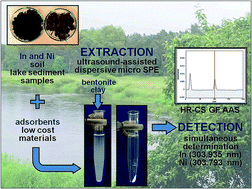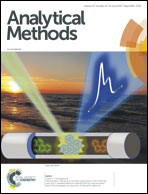Low cost adsorbents in ultrasound-assisted dispersive micro solid-phase extraction for simultaneous determination of indium and nickel by high-resolution continuum source graphite furnace atomic absorption spectrometry in soils and sediments
Abstract
As a sample preparation step, ultrasound-assisted dispersive micro solid-phase extraction (USA DMSPE) with low cost materials as an adsorbent is presented. The extraction capabilities of eight low cost materials were investigated. The best results were obtained for bentonite clay. The use of high-resolution continuum source graphite furnace atomic absorption spectrometry (HR-CS GF AAS) for simultaneous determination of two elements after extraction was developed. The primary absorption line at 303.935 nm was used for the determination of indium, and an adjacent secondary line at 303.793 nm for nickel. Both absorption lines were within the wavelength interval covered by the linear charge-coupled device (CCD) array detector. Some essential parameters of the extraction technique such as the amount of adsorbent, pH of sample solution, ultrasonication and centrifugation time, and slurry solution preparation before injection to HR-CS GF AAS as well as main parameters of spectrometer were studied. Detection limits of 0.01 mg L−1 and 0.26 mg L−1 were found for In and Ni, respectively. The precision, expressed as the relative standard deviation during real sample analysis, ranged from 2 to 11%. To investigate the accuracy of the developed method, digested CRMs (soils and sediments) were evaluated with a recovery between 90% and 117% for both analytes. The values found for Ni and In (after spiking) were not significantly different from those of the certified or added ones. The presented method was applied to extraction and the simultaneous determination of trace amounts of In and Ni in soil and lake sediment samples.

- This article is part of the themed collection: Analytical Methods Recent HOT articles


 Please wait while we load your content...
Please wait while we load your content...